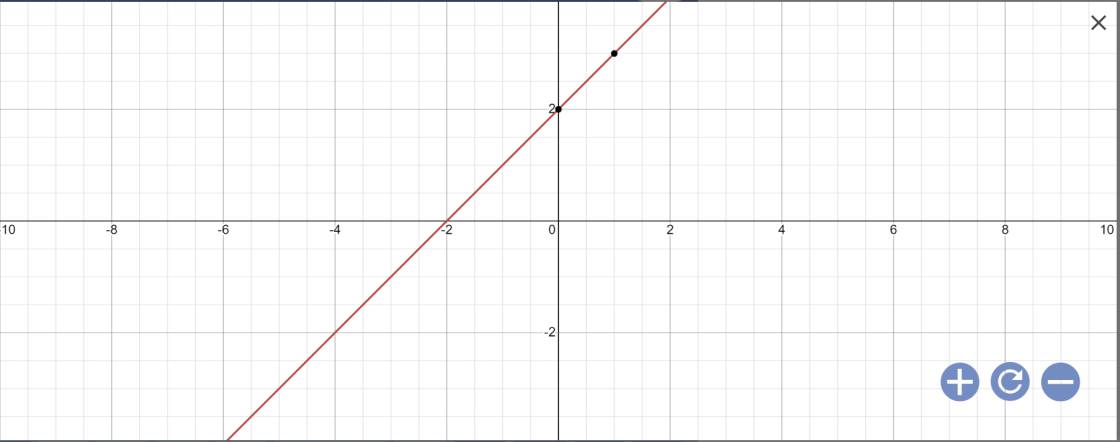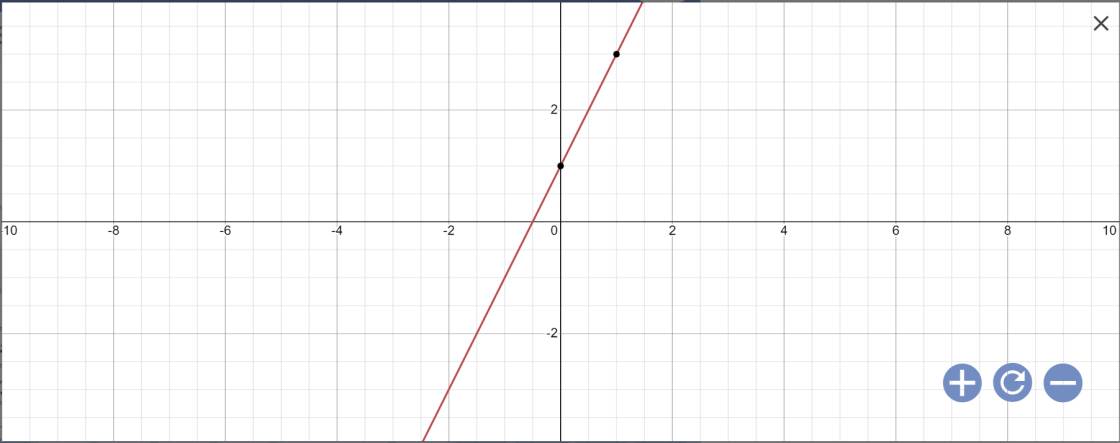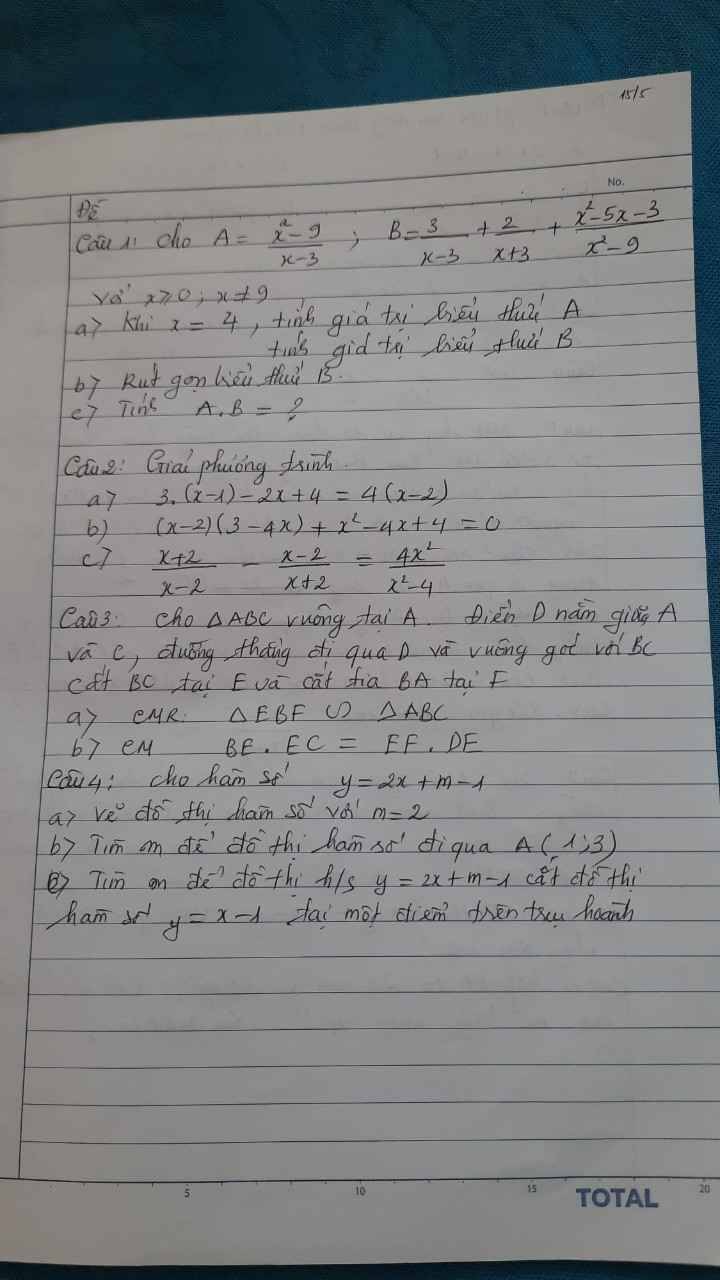Cho \(\Delta\)ABC cân tại A, H là trung điểm của BC, HE\(\perp\)AC={E}, O là trung điểm của HE, BK\(\perp\)AC={K}, BE\(\cap\)AO={I}
a,CM ,\(\Delta\)AHE đồng dạng \(\Delta\)BCK
b,CM ,AE.EK=BK.OE
c,OA\(\perp\)BE
Hãy nhập câu hỏi của bạn vào đây, nếu là tài khoản VIP, bạn sẽ được ưu tiên trả lời.

Bài 2:
a: 7-3x=9-x
=>-3x+x=9-7
=>-2x=2
=>x=-1
b: \(\dfrac{x+2}{3}+\dfrac{3x-1}{5}=-2\)
=>\(\dfrac{5\left(x+2\right)+3\left(3x-1\right)}{15}=-2\)
=>\(5\left(x+2\right)+3\left(3x-1\right)=-30\)
=>5x+10+9x-3=-30
=>14x+7=-30
=>14x=-37
=>\(x=-\dfrac{37}{14}\)
Bài 1:
a:
(d): y=x+2
=>Hệ số góc là a=1>0
=>Góc tạo bởi (d) với trục Ox là góc nhọn
b: (d')//(d)
=>\(\left\{{}\begin{matrix}a=1\\2\ne-2\left(đúng\right)\end{matrix}\right.\)
=>a=1
c: 

Bài 2:
a: \(x^2\left(x-2\right)+2-x=0\)
=>\(x^2\left(x-2\right)-\left(x-2\right)=0\)
=>\(\left(x-2\right)\left(x^2-1\right)=0\)
=>(x-2)(x+1)(x-1)=0
=>\(\left[{}\begin{matrix}x-2=0\\x+1=0\\x-1=0\end{matrix}\right.\)
=>\(\left[{}\begin{matrix}x=2\\x=-1\\x=1\end{matrix}\right.\)
b: \(x^2-9x^3=x^2-9x\)
=>\(9x^3=9x\)
=>\(x^3=x\)
=>\(x^3-x=0\)
=>\(x\cdot\left(x^2-1\right)=0\)
=>x(x-1)(x+1)=0
=>\(\left[{}\begin{matrix}x=0\\x-1=0\\x+1=0\end{matrix}\right.\)
=>\(\left[{}\begin{matrix}x=0\\x=1\\x=-1\end{matrix}\right.\)
c: \(x\left(x+2\right)+x^2=-2x\)
=>\(x\left(x+2\right)+x^2+2x=0\)
=>2x(x+2)=0
=>x(x+2)=0
=>\(\left[{}\begin{matrix}x=0\\x=-2\end{matrix}\right.\)
d: \(\left(x+1\right)\left(x^2+4\right)=x^2+x\)
=>\(\left(x+1\right)\left(x^2+4\right)-x\left(x+1\right)=0\)
=>\(\left(x+1\right)\left(x^2-x+4\right)=0\)
mà \(x^2-x+4=\left(x-\dfrac{1}{2}\right)^2+\dfrac{15}{4}>=\dfrac{15}{4}\forall x\)
nên x+1=0
=>x=-1

Câu 3:
a: Xét ΔBEF vuông tại E và ΔBAC vuông tại A có
\(\widehat{EBF}\) chung
Do đó: ΔBEF~ΔBAC
b: Xét ΔEDC vuông tại D và ΔEBF vuông tại E có
\(\widehat{EDC}=\widehat{EBF}\left(=90^0-\widehat{ACB}\right)\)
Do đó: ΔEDC~ΔEBF
=>\(\dfrac{ED}{EB}=\dfrac{EC}{EF}\)
=>\(ED\cdot EF=EB\cdot EC\)
Câu 1:
a:
\(A=\dfrac{x^2-9}{x-3}=\dfrac{\left(x-3\right)\left(x+3\right)}{x-3}=x+3\)
Thay x=4 vào A, ta được:
A=4+3=7
Thay x=4 vào B, ta được:
\(B=\dfrac{3}{4-3}+\dfrac{2}{4+3}+\dfrac{4^2-5\cdot4-3}{4^2-9}\)
\(=3+\dfrac{2}{7}+\dfrac{-7}{7}=3+\dfrac{2}{7}-1=2+\dfrac{2}{7}=\dfrac{16}{7}\)
b: \(B=\dfrac{3}{x-3}+\dfrac{2}{x+3}+\dfrac{x^2-5x-3}{x^2-9}\)
\(=\dfrac{3}{x-3}+\dfrac{2}{x+3}+\dfrac{x^2-5x-3}{\left(x-3\right)\left(x+3\right)}\)
\(=\dfrac{3\left(x+3\right)+2\left(x-3\right)+x^2-5x-3}{\left(x-3\right)\left(x+3\right)}\)
\(=\dfrac{3x+9+2x-6+x^2-5x-3}{\left(x-3\right)\left(x+3\right)}=\dfrac{x^2}{\left(x-3\right)\left(x+3\right)}\)
c: \(A\cdot B=\left(x+3\right)\cdot\dfrac{x^2}{\left(x-3\right)\left(x+3\right)}=\dfrac{x^2}{x-3}\)

Câu 4:
a: Thay m=2 vào y=2x+m-1, ta được:
y=2x+2-1=2x+1
Vẽ đồ thị:

b: Thay x=1 và y=3 vào y=2x+m-1, ta được:
m-1+2=3
=>m+1=3
=>m=2
c: Thay y=0 vào y=x-1, ta được:
x-1=0
=>x=1
Thay x=1 và y=0 vào y=2x+m-1, ta được:
\(2\cdot1+m-1=0\)
=>m+1=0
=>m=-1
Câu 2:
a: \(3\left(x-1\right)-2x+4=4\left(x-2\right)\)
=>\(4x-8=3x-3-2x+4\)
=>\(4x-8=x+1\)
=>3x=9
=>x=3
b: \(\left(x-2\right)\left(3-4x\right)+x^2-4x+4=0\)
=>\(\left(x-2\right)\left(3-4x\right)+\left(x-2\right)^2=0\)
=>\(\left(x-2\right)\left(3-4x+x-2\right)=0\)
=>(x-2)(1-3x)=0
=>\(\left[{}\begin{matrix}x=2\\x=\dfrac{1}{3}\end{matrix}\right.\)
c: ĐKXĐ: \(x\notin\left\{2;-2\right\}\)
\(\dfrac{x+2}{x-2}-\dfrac{x-2}{x+2}=\dfrac{4x^2}{x^2-4}\)
=>\(\dfrac{\left(x+2\right)^2-\left(x-2\right)^2}{\left(x-2\right)\left(x+2\right)}=\dfrac{4x^2}{\left(x-2\right)\left(x+2\right)}\)
=>\(4x^2=x^2+4x+4-x^2+4x-4\)
=>\(4x^2=8x\)
=>\(x^2=2x\)
=>x(x-2)=0
=>\(\left[{}\begin{matrix}x=0\left(nhận\right)\\x=2\left(loại\right)\end{matrix}\right.\)


a: Xét ΔOAB và ΔOCD có
\(\widehat{OAB}=\widehat{OCD}\)(AB//CD)
\(\widehat{AOB}=\widehat{COD}\)(hai góc đối đỉnh)
Do đó: ΔOAB~ΔOCD
=>\(\dfrac{OA}{OC}=\dfrac{OB}{OD}\)
=>\(\dfrac{OA+OC}{OC}=\dfrac{OB+OD}{OD}\)
=>\(\dfrac{AC}{OC}=\dfrac{BD}{OD}\)
=>\(\dfrac{DO}{BD}=\dfrac{CO}{CA}\)
b: \(AC^2-BD^2\)
\(=AD^2+DC^2-\left(AB^2+AD^2\right)\)
\(=AD^2+DC^2-AB^2-AD^2\)
\(=DC^2-AD^2\)

a: Xét ΔOAB và ΔOCD có
\(\widehat{OAB}=\widehat{OCD}\)(AB//CD)
\(\widehat{AOB}=\widehat{COD}\)(hai góc đối đỉnh)
Do đó: ΔOAB~ΔOCD
=>\(\dfrac{OA}{OC}=\dfrac{OB}{OD}\)
=>\(\dfrac{OA+OC}{OC}=\dfrac{OB+OD}{OD}\)
=>\(\dfrac{AC}{OC}=\dfrac{BD}{OD}\)
=>\(\dfrac{DO}{BD}=\dfrac{CO}{CA}\)
b: \(AC^2-BD^2\)
\(=AD^2+DC^2-\left(AB^2+AD^2\right)\)
\(=AD^2+DC^2-AB^2-AD^2\)
\(=DC^2-AD^2\)

a: Để (d) có hệ số góc bằng -2 thì m-1=-2
=>m=-1
b: Thay x=-3 và y=0 vào (d), ta được:
\(-3\left(m-1\right)+2m=0\)
=>-3m+3+2m=0
=>3-m=0
=>m=3
c: Thay x=0 và y=2 vào (d), ta được:
0(m-1)+2m=2
=>2m=2
=>m=1
d: Để (d)//(d1) thì \(\left\{{}\begin{matrix}m-1=-3\\2m\ne4\end{matrix}\right.\)
=>\(\left\{{}\begin{matrix}m=-2\\m\ne2\end{matrix}\right.\)
=>m=-2
a) Tìm để có hệ số góc bằng -2.
Hệ số góc của đường thẳng là . Để có hệ số góc bằng -2, ta giải phương trình:
b) Tìm để cắt trục hoành tại điểm có hoành độ bằng -3.
Khi cắt trục hoành, , từ đó:
c) Tìm để cắt trục tung tại điểm có tung độ bằng 2.
Khi cắt trục tung, , khi đó:
\(\Rightarrow\)
d) Tìm để song song với đường thẳng : .
Đường thẳng sẽ song song với nếu hệ số góc của bằng hệ số góc của
Kết luận:
a)
b) 3/5
c)
d)







